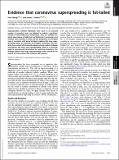Evidence that coronavirus superspreading is fat-tailed
Author(s)
Wong, Felix; Collins, James J.
DownloadPublished version (1.353Mb)
Publisher Policy
Publisher Policy
Article is made available in accordance with the publisher's policy and may be subject to US copyright law. Please refer to the publisher's site for terms of use.
Terms of use
Metadata
Show full item recordAbstract
Superspreaders, infected individuals who result in an outsized number of secondary cases, are believed to underlie a significant fraction of total SARS-CoV-2 transmission. Here, we combine empirical observations of SARS-CoV and SARS-CoV-2 transmission and extreme value statistics to show that the distribution of secondary cases is consistent with being fat-tailed, implying that large superspreading events are extremal, yet probable, occurrences. We integrate these results with interaction-based network models of disease transmission and show that superspreading, when it is fat-tailed, leads to pronounced transmission by increasing dispersion. Our findings indicate that large superspreading events should be the targets of interventions that minimize tail exposure.
Date issued
2020-11Department
Massachusetts Institute of Technology. Institute for Medical Engineering & Science; Massachusetts Institute of Technology. Department of Biological EngineeringJournal
Proceedings of the National Academy of Sciences
Publisher
National Academy of Sciences
Citation
Wong, Felix and James J. Collins. "Evidence that coronavirus superspreading is fat-tailed." Proceedings of the National Academy of Sciences (November 2020): dx.doi.org/10.1073/pnas.2018490117.
Version: Final published version
ISSN
0027-8424
1091-6490